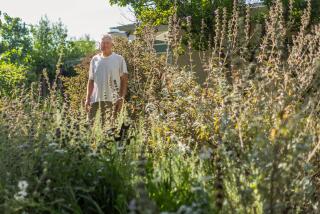Growing Attraction for Late Bloomers
- Share via
POUND RIDGE, N.Y. — A farmer who hires teen-agers is quoted in a village weekly as saying “they come here thinking tomatoes grow underground. Kids coming here to weed have plucked out my pepper plants and have planted onions upside down.”
Should kids know better, I wonder? I didn’t start gardening until I was 35, and was so ignorant the first time out I emptied a whole packet of lettuce seed into a 6-foot row before my horrified father-in-law could grab my arm.
But my goof didn’t dampen my eagerness.
Now, nearing 74, I make a lettuce packet last four or five years and I save wood ashes from the Franklin stove to fatten my beets. I’ve agonized over frost and drought and the raccoon has beaten me time and again to my best corn.
But, learning all the time, I look with pride at my 20-year-old asparagus bed, my pencil-thin French beans and the gloriously red radicchio peeking through the mulch and snow on a winter day.
The Barefoot Boy, as John Greenleaf Whittier pictured him 135 years ago, walked hand in hand with nature and talked to her face to face. But was he a gardener? How many of our teen-age children garden of their own free will?
And how about vegetables?
I dusted off an old Whittier and found that the lad with cheeks of tan knew all about woodchucks, moles, turtles, robins, orioles, wasps, groundnuts, lilies, berries and apples. But no beans or onions in the 102 lines.
Did Whittier forget the vegetables? Or, in America’s pastoral age, was it quietly understood that vegetables were not a leisure activity for children? A farmer of our own day, reminiscing in the New York Times about his childhood, regrets he never played much baseball. “I had to rush home from school to help my father with the planting.”
Aside from horticultural geniuses like Luther Burbank, many gardeners seem to be late bloomers. In my own family, I’ve seen my son, an artist, smitten in his mid-30s. He started because he wanted to paint flowers, like Claude Monet, but quickly he was deep into catalogues and manuals, potting soil, flats, tools, trips to nurseries, cold frames, mulches, hoses, trellises. Even botanical names.
And it doesn’t take forever to get pretty good. Unlike a heartless golf ball, plants help you. They want to live and “make it” as much as you do.
A Gallup poll found gardening to be America’s leading pastime, more popular than golf, jogging, biking, tennis and swimming.
But working the soil abounds in irony and paradox. On city rooftops and back yards, amateurs multiply, while real farmers, once a multitude, dwindle in the greatest agricultural nation. Some seek loans and therapy even as a few giants achieve miracles of production.
Astonishing machines, with cash the ultimate target, spew out spotless tomatoes as hard as baseballs, and as tasteless, while the greenest amateur, barely knowing enough to water his plants, exults over his first triumph, a juicy tomato with that old-time flavor.
A 30ish city friend came to see us at asparagus time. Asparagus is one of man’s oldest companions, very little different in today’s cultivated state from the wild spears harvested by our forebears. My friend’s eyes widened when he saw the purplish spears poking up through the hay mulch, self-contained beauties all ready for the cooking pot.
“Is that how they grow!?” he exclaimed.
I thought I read the pleasure of discovery in his eyes. Another gardener down the road?






